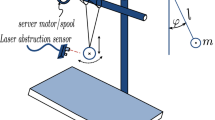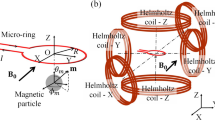Abstract
A mechanical system is considered that consists of a rotating base and a rigid body which can rotate with respect to the base around the axis coinciding with the axis of the base rotation. The control of the body’s motion with respect to the base is performed using a direct (high-torque) electric drive. The voltage applied across armature circuit terminals of the motor serves as a control variable. A dynamical model of the system is proposed that takes into account the friction moment in the rolling bearings with respect to the rotation axis. The rolling-friction moment is represented by an odd function of the angular velocity of body rotation that has a jump discontinuity at zero, as is the case for the dry-friction characteristic. An optimal control problem for bringing the body to the specified angular position in the absence of friction is solved. The time integral of a quadratic function of the control and phase variables is the functional to be minimized. For the system with friction, quasi-optimal feedback control laws are constructed, and sticking zones are estimated which are caused by sliding and rolling dry friction. Control modes are proposed with compensation for nonidealities and perturbation factors. Mathematical simulation is conducted and the dynamical characteristics of the process under control are determined.
Similar content being viewed by others
References
A. E. Borisov, A. I. Ivanov, S. V. Fedoseev, et al., “A method for optimizing the dynamic operating conditions of gravity-sensitive installations in terms of residual microaccelerations on board of orbiting spacecraft and device for its realization,” RF Patent No. 2369535, Byull. Izobret. No. 28 (2009).
A. E. Borisov, A. I. Ivanov, and G. A. Emel’yanov, “Turntable for stabilization of the processing unit angular position with respect to the microacceleration vector,” in Proceedings of the 46th Scientific Readings in Memory of K. E. Tsiolkovskii (Nasha Tipografiya, Kaluga, 2011), pp. 124–125.
A. E. Borisov, V. L. Levtov, V. V. Romanov, and N. V. Tarasenko, “A set of technical means to ensure the controlled dynamic conditions for investigations of gravity-sensitive systems researches,” Kosmonavt. Raketostroen., No. 4, 168–173 (2007).
L. D. Akulenko, N. N. Bolotnik, A. E. Borisov, A. A. Gavrikov, and G. A. Emel’yanov, “Control of the apparent acceleration of a rigid body attached to a movable base by means of a two-degree-of-freedom gimbal,” J. Comput. Syst. Sci. Int. 51, 339 (2012).
I. V. Kragel’skii and I. E. Vinogradova, Friction Coefficients, a Reference Manual (Mashgiz, Moscow, 1962) [in Russian].
A. Yu. Ishlinskii, Applied Problems of Mechanics, Vol. 2: Mechanics of Elastic and Absolutely Rigid Bodies (Nauka, Moscow, 1986) [in Russian].
V. V. Andronov and V. F. Zhuravlev, Dry Friction in Problems of Mechanics (Regular. Khaotich. Dinamika, Inst. Komp’yut. Issled., Moscow, Izhevsk, 2010) [in Russian].
M. G. Chilikin and A. S. Sandler, General Course of Electric Drives (Energoizdat, Moscow, 1981) [in Russian].
L. D. Akulenko, S. K. Kaushinis, and G. V. Kostin, “Influence of the dry friction upon controlled motion of electromechanical systems,” Izv. Akad. Nauk SSSR, Tekh. Kibern., No. 1, 65–74 (1994).
Ya. N. Roitenberg, Automatic Control (Nauka, Moscow, 1971) [in Russian].
Ya. Z. Tsypkin and P. V. Bromberg, “On the degree of stability of linear systems,” Izv. Akad. Nauk SSSR, Otd. Tekh. Nauk, No. 12, 1163–1168 (1945).
E. Zajac, “Bounds on the decay rate of damped linear systems,” Q. Appl. Math. 20, 383–384 (1963).
V. A. Sarychev, “Problems of artificial satellite orientation,” in Achievements in Science and Engineering, Vol. 11 (VINITI, Moscow, 1978) [in Russian].
N. N. Bolotnik, Optimization of Shock and Vibration Isolation Systems (Nauka, Moscow, 1983) [in Russian].
Author information
Authors and Affiliations
Corresponding author
Additional information
Original Russian Text © L.D. Akulenko, N.N. Bolotnik, A.E. Borisov, A.A. Gavrikov, G.A. Emel’yanov, 2015, published in Izvestiya Akademii Nauk. Teoriya i Sistemy Upravleniya, 2015, No. 3, pp. 3–20.
Rights and permissions
About this article
Cite this article
Akulenko, L.D., Bolotnik, N.N., Borisov, A.E. et al. Quasi-optimal control of rotation of a rigid body about a fixed axis taking friction into account. J. Comput. Syst. Sci. Int. 54, 331–348 (2015). https://doi.org/10.1134/S1064230715030028
Received:
Accepted:
Published:
Issue Date:
DOI: https://doi.org/10.1134/S1064230715030028




